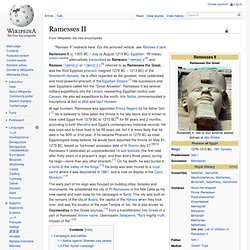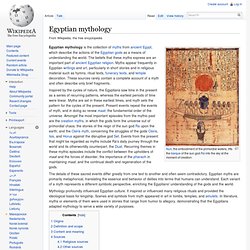

History of Egypt. Ancient Egypt. Ancient Egypt was an ancient civilization of Northeastern Africa, concentrated along the lower reaches of the Nile River in what is now the modern country of Egypt.

It is one of six civilizations globally to arise independently. Egyptian civilization coalesced around 3150 BC (according to conventional Egyptian chronology)[1] with the political unification of Upper and Lower Egypt under the first pharaoh.[2] The history of ancient Egypt occurred in a series of stable Kingdoms, separated by periods of relative instability known as Intermediate Periods: the Old Kingdom of the Early Bronze Age, the Middle Kingdom of the Middle Bronze Age and the New Kingdom of the Late Bronze Age. History Map of ancient Egypt, showing major cities and sites of the Dynastic period (c. 3150 BC to 30 BC) Predynastic period A typical Naqada II jar decorated with gazelles. In Predynastic and Early Dynastic times, the Egyptian climate was much less arid than it is today. Early Dynastic Period (c. 3050 –2686 BC) Hatshepsut. For other ancient Egyptians called Maatkare, see Maatkare.

Hatshepsut (/hætˈʃɛpsʊt/;[4] also Hatchepsut; meaning Foremost of Noble Ladies;[5] 1507–1458 BC) was the fifth pharaoh of the Eighteenth Dynasty of Egypt. She was the second historically confirmed female pharaoh, the first being Sobekneferu.[6] (Various other women may have also ruled as pharaohs regnant or at least regents before Hatshepsut, as early as Neithhotep around 1600 years prior.) Hatshepsut came to the throne of Egypt in 1478 BC. Officially, she ruled jointly with Thutmose III, who had ascended to the throne the previous year as a child of about two years old. Hatshepsut was the chief wife of Thutmose II, Thutmose III’s father. Reign[edit] Jar bearing the cartouche of Hatshepsut. Trade with other countries was re-established; here trees transported by ship from Punt are shown being moved ashore for planting in Egypt—relief from Hatshepsut mortuary temple Dating the beginning of her reign is more difficult, however. Ramesses II. Ramesses II (c. 1303 BC – July or August 1213 BC; Egyptian: *Riʻmīsisu,[citation needed] alternatively transcribed as Rameses /ˈræməsiːz/[5] and Ramses /ˈræmsiːz/ or /ˈræmziːz/),[6] referred to as Ramesses the Great, was the third Egyptian pharaoh (reigned 1279 BC – 1213 BC) of the Nineteenth dynasty.

He is often regarded as the greatest, most celebrated, and most powerful pharaoh of the Egyptian Empire.[7] His successors and later Egyptians called him the "Great Ancestor". Ramesses II led several military expeditions into the Levant, reasserting Egyptian control over Canaan. He also led expeditions to the south, into Nubia, commemorated in inscriptions at Beit el-Wali and Gerf Hussein. At age fourteen, Ramesses was appointed Prince Regent by his father Seti I.[7] He is believed to have taken the throne in his late teens and is known to have ruled Egypt from 1279 BC to 1213 BC[8] for 66 years and 2 months, according to both Manetho and Egypt's contemporary historical records. Egyptian mythology. Egyptian mythology is the collection of myths from ancient Egypt, which describe the actions of the Egyptian gods as a means of understanding the world.

The beliefs that these myths express are an important part of ancient Egyptian religion. Myths appear frequently in Egyptian writings and art, particularly in short stories and in religious material such as hymns, ritual texts, funerary texts, and temple decoration. These sources rarely contain a complete account of a myth and often describe only brief fragments. The details of these sacred events differ greatly from one text to another and often seem contradictory. Egyptian myths are primarily metaphorical, translating the essence and behavior of deities into terms that humans can understand. Mythology profoundly influenced Egyptian culture.
Origins[edit] The development of Egyptian myth is difficult to trace. Another possible source for mythology is ritual. Definition and scope[edit] Content and meaning[edit] Sources[edit]